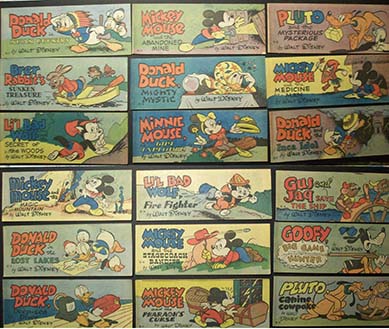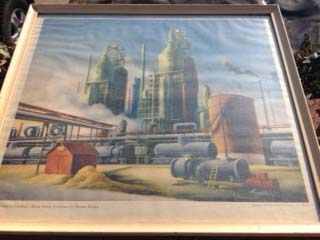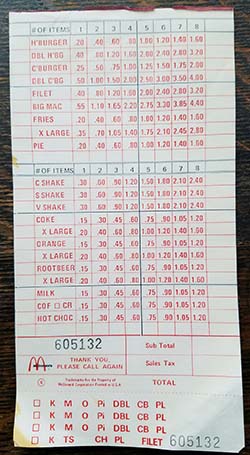 |
|
|||
 |
 |
|||
Copyright © Harry Rinker, LLC 2017 Questions
and Answers
QUESTION: When I was young, I had a great Disney comic book collection dating from the late 1940s through the early 1960s. When I was in the service, my mother gave them away. All that survives are 24 mini-comics that I acquired as Wheaties premiums. What is their value? – JK, Timberlake, OH, Email Question 
ANSWER: Between 1950 and 1952, Wheaties in conjunction with Walt Disney productions released four sets, each containing eight 32-page mini-comics. The mailing envelopes for the sets had an A, B, C, or D designation on the front. Each set was available for 15 cents plus one Wheaties box top. The first task is to determine if you have one or more complete sets. The titles and numbers are: A-1 Mickey Mouse & the Disappearing Island B-1 Mickey Mouse & the Pharaoh’s Curse C-1 Donald Duck & the Inca Idol D-1 Donald Duck in Indian Country Comparing the images in the illustrations that accompanied your email, you have complete B, C, and D sets. Unfortunately, the envelopes in which the mini-comic series was sent are missing. In order for a set to be complete, its envelope must be present. Condition is critical. For evaluation purposes, I am going to assume the comic grade between 6.5 and 7.0 on Overstreet’s 10-point comic grading scale. A C7 comics is: “F/VF 7.0 - Moderate reduction of cover reflectivity - minor creases allowed, minor foxing, interior cover yellowing, date stamps - initials - and store stamps are allowed, Slight rust migration allowed, Blunted corners, minor margin tears on interior pages allowed -- More and deeper stress lines allowed” On November 21, 2013, Hake’s Americana & Collectibles Auction sold a lot containing all four sets with envelopes and a Wheaties box advertising the set premium for $689.42. Although there are slight price variation between titles, an average C7 book value is between $20.00 and $22.50 per title. Hence, your collection has a retail market value between $480.00 and $550.00. The caveat is that with time and patience, it is possible to assemble a full set of each the series in C7 condition or better for less than $75.00 via the Internet. QUESTION: I bought a simple wooden frame measuring 21-inches by 18 3/4-inches for a dollar at a yard sale. I planned to use it to frame my Ponderosa burning map. Inside the frame was a colored print of a Thomas Hart Benton painting entitled “Fluid Catalytic Crackers, Baton Rouge, Louisiana.” The lower right reads: “Copyright, 1946, Standard Oil Company (New Jersey).” What information can you provide? – M, State College, PA, Email Question 
ANSWER: The print apparently was a corporate giveaway. I was not able to determine the circumstance for the distribution. I did discover that the Standard Oil Company of New Jersey had a corporate art collection and that this painting was part of that collection. The oil painting from which the print was made is part of the List Visual Arts Center which oversees the Massachusetts Institute of Technology, Cambridge, Massachusetts, Permanent Collection. The following information is taken from https://listart.mit.edu/collections/permanent-collection: “In 1951 MIT President James Killian, with Director of Libraries John Burchard, provided the impetus for a program for the visual arts on campus. In 1951, the MIT Permanent Collection was formally inaugurated, with a gift of 26 paintings and drawings from the Standard Oil Company of New Jersey. With no gallery for the permanent display of artwork on campus, the decision was made to exhibit the works throughout the campus, setting the precedent for the way the Permanent Collection is displayed today.” The Standard Oil of New Jersey Fluid Catalytic Cracker was the first commercial fluid catalytic cracker, most likely the reason for engaging such a prominent artist as Thomas Hart Benton to paint its portrait. Standard Oil of New Jersey, Standard Oil of Indiana, M. W. Kellogg Co., and I. G. Farben began research on developing a cracking process in 1938. Other companies joined the group. On May 9, 1940, Standard Oil of New Jersey’s Board of Directors authorized funds to build the first “powdered catalyst” cracking plant. An experimental cracker was built in Baton Rouge. Its success led to the larger cracker pictured in the painting/print. Construction of PCLA No. 1 was completed on May 1, 1942. The PCLA No. 1 Cracker was 19 stories high, utilized 6,000 tons of steel in its construction, and had 85 miles of pipe. [For a detailed history of the fluid catalytic cracker, see: www.ogj.com/articles/print/ volume-90/issue-20/in-this-issue/general-interest/fluid-catalytic-cracking-hits-50-year-mark-on-the-run.html] Because your image is a print, its value is limited. There are two pluses. First, it is a print of a Thomas Hart Benton painting. Second, it is a powerful industrial image, one that has appeal to historians of technology, engineers, those associated with oil refining, and Louisiana collectors. The value of your print is between $10.00 and $15.00. QUESTION: In going through boxes of my stuff, I found the remains (10 pages) of a McDonald’s order pad. I worked at McDonalds while in high school in 1973. A hamburger was 20 cents, a cheese burger 25 cents, a filet sandwich 40 cents, a Big Mac 55 cents, a chocolate, strawberry, or vanilla shake 30 cents each, and a Coke, orange or root beer soda 15 cents each. I have tried to find similar examples on the Internet but had no success. Do the surviving order pad pages have any value or should I just throw them out? – RV, Cedar Falls, IA 
ANSWER: Do not throw them out. Nostalgia is worth money, albeit the exact amount is always the issue. See: www.mcspotlight.org/company/company_history.html for a quick overview of McDonald’s history. Highlights include the introduction of the filet-of-fish sandwich in 1964, the Big Mac in 1968, and the Egg McMuffin in 1973. Based on the image of a page from the order pad that accompanied your email, the Egg McMuffin was not available at the McDonalds at which you worked. Your order pad is an example of the antiques and collectibles concept that the whole is not equal to the sum of the parts. If offered as a unit, your 1973 order pad should sell between $35.00 and $45.00. Given the number of McDonald collectors and those who remember eating at McDonalds in the early 1970s, an individual tear sheet from the pad could realize between $10.00 and $15.00. My suggestion is to go to a local Big Box store and buy some cheap one or two dollar frames. Sell the pages as framed displays. I recommend asking a minimum of $25.00 per framed example plus shipping. The value of an antique or collectible does not always rest in the object. It often is influenced by creative marketing and seller hustle. Harry L. Rinker welcomes questions from readers about
collectibles, those mass-produced items from the twentieth and twenty-first centuries.
Selected letters will be answered in this column.
Harry cannot provide personal answers.
Photos and other material submitted cannot be
returned.
Send your questions to: Rinker on Collectibles, 5955 Mill
Point Court SE, Kentwood, MI 49512.
You also can e-mail your questions to
harrylrinker@aol.com.
Only e-mails containing a full name and mailing address
will be considered.
You can listen
and participate in
WHATCHA GOT?, Harry’s
antiques and collectibles radio call-in show, on Sunday mornings between 8:00 AM
and 10:00 AM Eastern Time.
If you
cannot find it on a station in your area,
WHATCHA GOT?
streams live on the Internet at www.gcnlive.com.
SELL, KEEP OR TOSS?: HOW TO DOWNSIZE A HOME,
SETTLE AN ESTATE, AND APPRAISE PERSONAL PROPERTY
(House of Collectibles, an imprint of Random House Information Group, $17.99),
Harry’s latest book, is available at your favorite bookstore and via
www.harryrinker.com.
|
||||